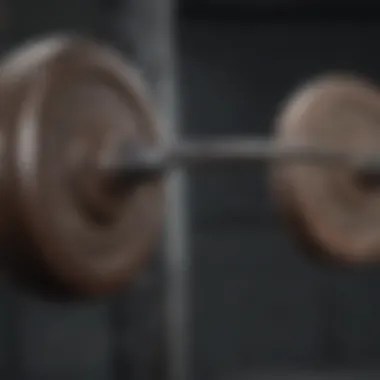Understanding the Weight Specifications of a Duffalo Bar


Intro
The Duffalo Bar is becoming more popular among strength training enthusiasts. Understanding its weight and specifications is essential to make informed choices. This bar offers unique features compared to traditional barbells, influencing how strength training can be approached.
In this article, we will examine the weight specifications of the Duffalo Bar, how different versions vary in weight, and why knowledge about these aspects helps in designing effective workout plans. Additionally, we will explore comparisons with regular barbells and their implications for performance and exercise. By the end, readers will have a clearer understanding of the Duffalo Bar's place in their fitness journeys.
Key Takeaways
- The Duffalo Bar typically weighs around 45 pounds (20.4 kg) but has variations that may influence lifting experience.
- The unique design of the Duffalo Bar helps in maintaining better form during lifts, reducing strain on the shoulders and wrists.
- Different training applications such as squats and bench press can benefit from using the Duffalo Bar, especially for those experiencing discomfort with standard bars.
- Performance considerations include how the bar's weight distribution may alter lifting dynamics, making it a suitable choice for diverse training needs.
"Understanding the weight and design differences of the Duffalo Bar can greatly enhance one's strength training effectiveness."
Key Statistics
- Weight of standard Duffalo Bar: 45 pounds (20.4 kg)
- Length of the bar: 86 inches (218.4 cm)
- The grip width: 32 inches (81.3 cm)
Practical Tips
- Incorporate the Duffalo Bar Gradually
Start with lighter weights to understand the differences in how your body responds to this type of bar. - Focus on Form
With the unique curvature, be aware of your form during lifts. The design may encourage better posture, but it’s key to maintain proper technique. - Adjust Your Routine
Experiment with varying exercise routines that can utilize the Duffalo Bar effectively. For example, try using it for overhead presses or curls to see how it feels compared to your usual bar. - Seek Professional Advice
Consulting fitness trainers or coaches can provide personalized insights into how best to include the Duffalo Bar in your workouts.
By focusing on these practical steps, one can enhance their training and make informed decisions about including the Duffalo Bar in their fitness routines.
Prologue to Duffalo Bars
The Duffalo Bar has emerged as an essential tool in the strength training arena. Its unique design and weight specifications make it a subject worth exploring for fitness enthusiasts and professionals alike. Understanding the Duffalo Bar is significant, as it holds specific benefits that can enhance workout routines. This section will unpack the core elements related to Duffalo Bars, the relevance of their weight, and considerations that can influence workout effectiveness.
Definition of a Duffalo Bar
A Duffalo Bar is a specialized weightlifting bar designed primarily for strength training. It features a distinctive curved design that allows the weight to be positioned differently when compared to standard straight bars. This design shifts the load's distribution during exercises, which can lead to improved performance in movements like squats, bench presses, and deadlifts.
Physically, Duffalo Bars are typically manufactured in different weights, maximizing their utility for users with varying strength levels. They are often made from high-quality steel to ensure durability and proper functionality, enabling athletes to exert significant force without compromising safety. The versatility in both exercises and weight options makes the Duffalo Bar a preferred choice in many gym settings.
History and Development
The origins of the Duffalo Bar date back to its creation by strength enthusiasts seeking an alternative to conventional barbells. Over the years, it has evolved based on feedback from lifters and coaches who noticed its biomechanical advantages. The first iterations were more basic, but recent versions incorporate advanced engineering that enhances their functionality.
Initially, the Duffalo Bar was primarily used by professional athletes and in specialized training facilities. As its benefits became more apparent, it gained traction among personal trainers and recreational lifters. Today, it is a common feature in gym facilities, often regarded as a valuable tool for improving performance and rehabilitation. Its growing popularity reflects the broader trend of diversifying strength training methodologies to accommodate varying fitness goals.
Overall, the exploration of Duffalo Bars reveals how this equipment can transform traditional weightlifting approaches. As we delve deeper into its weight specifications in the following sections, we will see the practical implications for trainers and their clients.
Weight Specifications
Understanding weight specifications is crucial for anyone involved in strength training. The weight of a Duffalo Bar impacts its usability, effectiveness, and the type of workouts that can be performed. Knowledge of weight specifications enables fitness enthusiasts and professionals to tailor their training efficiently. Each detail regarding weight translates to performance implications, injury risks, and overall training benefits.
Standard Duffalo Bar Weight


The standard Duffalo Bar typically weighs approximately 45 pounds. This weight aligns with traditional barbells used in many gyms. However, its unique design gives it a different functional profile. The curve in the bar helps distribute weight differently.
Standard users appreciate this configuration especially for certain lifts. It allows for better biomechanics during exercises, such as squats and bench presses. The weight distribution mitigates stress on the shoulders and wrists, making it a preferred choice for many lifters.
Variations in Weight
Variations in Duffalo Bar weights exist to accommodate different user needs and training goals. Some Duffalo Bars weigh 35 pounds, while others may be designed to exceed 55 pounds. Different brands, like Titan Fitness or EliteFTS, may have different specifications. This variation allows lifters to select a bar that aligns with their personal performance and strength levels.
When selecting a Duffalo Bar, consider not only the weight but also how it fits into your training program. Heavier bars can stimulate greater muscle activation but can also increase the risk of injury if improperly used. Lighter bars enable focus on technique without overloading the muscles prematurely. Understanding these aspects can help in making informed decisions.
Materials and Design
The materials and design of the Duffalo Bar are crucial for its performance and usability. It affects not only its strength and durability but also how it feels during each lift. Understanding these aspects allows fitness professionals to make informed decisions when incorporating the bar into their training regimens. This section will focus on the construction materials used in a Duffalo Bar and its unique design features.
Construction Materials
The materials used in the construction of a Duffalo Bar are significant for both performance and longevity. Most Duffalo Bars are crafted from high-strength steel. Steel is favored for its resistance to bending and breaking, which is especially important under heavy loads. This means that users can lift considerable weights with confidence, knowing that the bar can withstand stress.
Some bars are coated with a protective finish to prevent rust and enhance grip. This finish can also contribute to the overall aesthetic appeal of the bar. The choice of materials extends to the sleeves, too. These can be made from nylon or bronze to allow for smoother rotation, reducing stress on the user's wrists and improving the overall lifting experience.
Key considerations include:
- Durability: The steel quality directly influences the lifespan of the bar.
- Grip: A good coating can provide better handling, particularly during intense workouts.
- Weight: The overall weight is affected by materials, which impacts how the bar behaves in use.
Design Features
The design of the Duffalo Bar is not just about looks. It serves a functional purpose that enhances its usability for various exercises. One of the most distinguishing features is its camber, which means the bar bends slightly in the center. This design allows for a more natural movement during squats and other lower body exercises, keeping the bar positioned properly over the lifter's center of gravity.
Another notable aspect is the wider grip options. The spacing between the grips accommodates different hand sizes, offering versatility for various lifts. This design feature also promotes better alignment, reducing the risk of injury. Additionally, the sleeves are often designed to accept standard Olympic weights for greater adaptability.
In summary, the design features include:
- Cambered shape: Promotes a more ergonomic lifting position.
- Wide grip variety: Allows for personalized hand placements.
- Compatible sleeves: Eases weight swapping and enhances usability.
Functional Benefits
Understanding the functional benefits of a Duffalo Bar is crucial for optimizing workout effectiveness. This equipment provides specific advantages that can enhance training outcomes, especially for strength training enthusiasts.
Biomechanical Advantages
The Duffalo Bar is designed to cater to the natural movement patterns of human biomechanics. Unlike a traditional straight barbell, the unique curve of the Duffalo Bar encourages a more natural grip. This design reduces stress on the shoulders and wrists during lifts, allowing for a more comfortable experience. The changes in grip angles made possible by the Duffalo Bar leads to better muscle activation in various exercises. This is particularly beneficial for those looking to avoid injuries while still delivering efficient performance.
It is also notable that the lifted weight distribution on the Duffalo Bar can lead to improved loading for the muscles involved. This allows lifters to experience targeted stimulation more effectively. Additionally, the bar's design encourages proper posture throughout lifts, reducing the risk of performing exercises incorrectly.
Adaptability for Various Exercises


One of the standout features of the Duffalo Bar is its adaptability for a wide range of exercises. From squats to bench presses, this bar has the capability to accommodate multiple training movements. Practitioners can easily incorporate it into their routines, which can help in diversification of workouts. This bar’s design permits a lower starting point for some lifts, making it effective for both novice and experienced lifters.
For example, when performing squats, the bar allows greater depth and fluid movement without compromising form. Similarly, during bench presses, users may find less strain on the shoulder joints while still achieving significant muscle engagement.
Moreover, the Duffalo Bar's weight offers flexibility for different training goals, such as strength building and rehabilitation. As a result, it serves as an invaluable tool for personal trainers and physical therapists aiming to create tailored programs.
In summary, the functional benefits of using a Duffalo Bar extend well beyond basic lifting. Its biomechanical advantages and adaptability for a variety of exercises make it a recommended tool for enhancing strength training routines and promoting safe workout practices.
Common Uses in Fitness Training
The Duffalo Bar has gained significance in the realm of fitness training due to its unique weight distribution and ergonomic benefits. Understanding its common uses can help fitness enthusiasts and professionals maximize their training effectiveness. Its application ranges from strength training to rehabilitation, offering a versatile tool that can adapt to various training needs.
Strength Training Applications
Since the Duffalo Bar is designed to alleviate stress on the shoulders and joints, it is particularly beneficial in strength training. One of its main advantages is the unique angle of the bar. This allows for a more natural grip, which in turn enhances stability during lifts. Users often find they can lift heavier weights without discomfort, as the Duffalo Bar reduces strain on shoulder ligaments.
This feature makes it a popular choice for exercises such as squats, bench presses, and deadlifts. The bar’s design helps in maintaining proper form, as it encourages users to keep their elbows tucked in, minimizing the risk of injury. It is especially useful for:
- Powerlifting: The bar accommodates a wider grip, allowing for greater muscle activation.
- Olympic Lifts: The Duffalo Bar enables better position management during complex lifts.
- Accessory Work: Exercises like rows and presses can be done more safely and effectively.
Rehabilitation and Physical Therapy
In the context of rehabilitation, the Duffalo Bar plays a crucial role. Many trainers and therapists utilize this bar to aid clients recovering from injuries. Its unique weight distribution aids in maintaining proper mechanics while promoting healing. As the user progresses, they can gradually increase the weight, allowing for a controlled strength-building environment.
The Duffalo Bar is particularly advantageous for:
- Shoulder Rehabilitation: The bar’s design helps individuals complete shoulder exercises without exacerbating pain.
- Knee Injury Recovery: Squatting with a Duffalo Bar can be easier on the knees, facilitating a safer recovery process.
- General Strength Restoration: It can be used for low-impact strength workouts that minimize stress on the body.
The adaptability of the Duffalo Bar makes it an essential tool across various training settings. Whether for strength training or rehabilitation purposes, understanding how to utilize it effectively can enhance the training experience and outcomes for many individuals.
"The Duffalo Bar provides a distinctive advantage in training, enabling users to maintain better form and reduce injury risk."
Comparative Analysis
The comparative analysis section serves as a crucial component of this article. By understanding how the Duffalo Bar stacks up against traditional barbells, readers will gain insight into the advantages and potential drawbacks of each equipment type. This knowledge is not merely academic; it directly informs training choices and enables users to tailor their workouts more effectively. Analyzing differences in weight, design, and biomechanical impact can lead to informed decisions that enhance workout efficiency.
Duffalo Bar vs. Traditional Barbells
When comparing the Duffalo Bar to traditional barbells, several key factors emerge. First, the design of the Duffalo Bar is distinctive in its curved shape. This curvature allows for a more natural lifting motion, which can lead to reduced strain on the shoulders and wrists. For individuals who have experienced discomfort or restrictions with straight bars, the Duffalo bar provides an alternative that accommodates their anatomy better.
Next, let's examine the weight distribution. While most conventional barbells have fixed weights, Duffalo Bars have specific weight features that can vary depending on the user’s goals and the exercises performed. The Duffalo Bar typically weighs around 45 pounds, similar to conventional Olympic bars, but variations exist that may offer lighter or heavier alternatives. This flexibility can be a significant advantage for both beginner and advanced athletes as they progress in their lifting capabilities.
Moreover, the grip of the Duffalo Bar is designed to enhance comfort and grip security. The flared ends allow for a wider grip as well, which can be particularly beneficial for various exercises such as squats and bench presses.
Weight Differences and Performance


Weight differences between the Duffalo Bar and standard barbells play an essential role in performance outcomes. A primary consideration is how the weight of the equipment influences each lift. The Duffalo Bar’s unique design can modify the center of gravity, which can alter the dynamics of an exercise. As a result, lifters may find that their performance is affected by these differences, particularly in compound lifts.
Research indicates that the slightly different loading and balance provided by the Duffalo Bar may lead to improved muscle activation during certain lifts. This can enhance functional strength, essential not just for aesthetics but for overall physical performance.
Additionally, understanding variations in the weights available can aid in programming effective training routines. The Duffalo Bar can facilitate progressive overload, which is vital for muscle growth and increased strength. When lifters appreciate how weight specifications affect their training results, they are better positioned to set and achieve realistic fitness goals.
In sum, the comparative analysis of the Duffalo Bar against traditional barbells offers essential insights into weight, design, and performance. By contemplating these factors, fitness professionals can guide their clients more effectively, ensuring that each individual’s training regimen aligns with their personal fitness journey.
Popularity and Community Feedback
The growing popularity of the Duffalo Bar in fitness communities highlights its significance not just as a piece of equipment, but also as a tool for enhancing training accessibility and effectiveness. As weightlifting continues to evolve, understanding the feedback from users becomes vital. The experiences shared by those who utilize the Duffalo Bar contribute valuable insights that can guide potential buyers and trainers in their decision-making processes.
User Experiences
Many users report favorable outcomes when incorporating the Duffalo Bar in their routines. Feedback often centers on comfort and versatility. Unlike traditional barbells, the Duffalo Bar features a unique design that allows for a more ergonomic grip. For instance, lifters often mention the reduced strain on their shoulders and wrists. This aspect alone has made it increasingly popular among individuals who might struggle with conventional lifting equipment.
Additionally, users have expressed satisfaction with the bar's adaptability. The Duffalo Bar lends itself well to various lifts, including squats, bench presses, and deadlifts. Many report that it allows them to explore new techniques and refine their form without the discomfort associated with standard bars.
"The Duffalo Bar transformed my workouts. I can lift heavier without pain while maintaining proper form," shares an avid lifter on a fitness forum.
Such anecdotes matter because they provide real-world validation of the claimed benefits. As users share their experiences through platforms like Reddit and Facebook, they enrich the community's understanding of the bar’s impact on strength training.
Trends Among Fitness Enthusiasts
The Duffalo Bar has not only gained traction among seasoned lifters but also draws interest from newcomers in the fitness world. Observations indicate a trend where fitness enthusiasts favor the Duffalo Bar for its effective introduction to weight training. Beginners often find it a less intimidating option compared to traditional barbells, which can appear daunting.
Furthermore, discussions in fitness circles highlight the bar as part of an emerging shift towards specialized equipment. More trainers begin to advocate for the Duffalo Bar, pointing to its ability to enhance strength-building routines.
Among different fitness communities, many users express enthusiasm for trying new exercises with the Duffalo Bar, showcasing its versatility beyond conventional lifts. As trends reveal, those who frequently engage on platforms like Reddit often share recommendations and their evolving workout routines, contributing to the growing enthusiasm surrounding this particular piece of equipment.
In summary, the popularity and community feedback surrounding the Duffalo Bar reflect a wave of acceptance and enthusiasm for innovative fitness solutions. User experiences provide insight into practical advantages while trends among enthusiasts indicate a meaningful shift in training preferences. This collective knowledge supports the case for incorporating the Duffalo Bar into various training settings, creating a more informed fitness landscape.
Finale
The final section of this article is fundamental in consolidating the information presented regarding the Duffalo Bar. Understanding the weight specifications and their practical implications ties back to the overarching goal of improving one's fitness routine. Knowledge about weight plays a crucial role in shaping both the efficacy and safety of workouts. For trainers and fitness enthusiasts alike, grappling with how weight influences performance can significantly enhance exercise outcomes.
Impact of Weight Knowledge on Training
Weight knowledge helps users tailor workouts suitable for their strength levels and goals. Properly incorporating the Duffalo Bar can result in enhanced muscle development and better biomechanical efficiency. Those who are aware of the weights they are lifting can systematically increase resistance over time, facilitating progressive overload, which is crucial for muscle growth.
In strength training, minimizing injury risk is also paramount. Knowing the right weight can prevent excessive strain on joints and muscles. Athletes and trainers who grasp the weight of the equipment they are using are more equipped to integrate the bar into safe lifting practices.
Encouragement for Informed Choices
This article encourages informed decision-making regarding the selection of strength-training tools. With many options available, understanding the distinct characteristics of the Duffalo Bar assists users in making choices that align with their fitness objectives. Informed individuals are more likely to appreciate how weight impacts performance and will exercise with more confidence.
Opting for a Duffalo Bar should be based on both personal fitness levels and specific training goals. Whether for recreational lifting or competitive training, selecting the right weight can enhance both enjoyment and effectiveness of workouts. Being informed helps build a sustainable fitness routine that promotes longevity and progress.
In summary, understanding weight is not just about numbers; it is about crafting an effective training strategy that promotes better health outcomes.
By synthesizing this information, individuals can make thoughtful decisions that resonate with their journey towards improved strength and overall wellness. This deeper knowledge ultimately empowers users to embrace the benefits of the Duffalo Bar fully.







